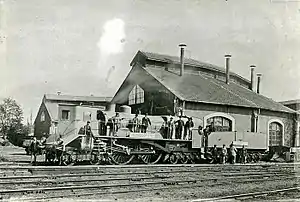| Thuile | |||||||||||||||||||||||||||||||||||
|---|---|---|---|---|---|---|---|---|---|---|---|---|---|---|---|---|---|---|---|---|---|---|---|---|---|---|---|---|---|---|---|---|---|---|---|
 Thuile locomotive at Chartres, 1900 | |||||||||||||||||||||||||||||||||||
| |||||||||||||||||||||||||||||||||||
| |||||||||||||||||||||||||||||||||||
| |||||||||||||||||||||||||||||||||||
| |||||||||||||||||||||||||||||||||||
The Thuile locomotive was a steam locomotive designed by M. Henri Thuile, of Alexandria, Egypt, and built in 1899.
History
Thuile proposed a 6-4-8 or 6-4-6 locomotive with 3-metre-diameter (9 ft 10 in) driving wheels, but this was not built.[1]
The design was taken up by Schneider, of Le Creusot, who built a 4-4-6 with 2.5-metre-diameter (8 ft 2 in) driving wheels, and a forward cab for the driver. The two-cylinder locomotive had Walschaerts valve gear and a double-lobed boiler of nickel-steel. The locomotive was exhibited at the International Exposition in Paris in 1900, and the trials were undertaken on the Chemin de Fer de l'Etat line between Chartres and Thouars. A speed of 117 kilometres per hour (73 mph) was attained hauling a load of 186 tonnes (183 long tons).[1]
The trials ended when Thuile was killed in June 1900 - apparently by leaning too far out of the locomotive and being in collision with a lineside pole[2] or a piece of scaffolding supporting an overbridge.[3] The locomotive was returned to Schneider. It was scrapped in 1904. The tender survived until at least 1946, when it was noted at Saint Pierre-des-Corps.[1]
References
- 1 2 3 "BIG WHEELS FOR HIGH SPEEDS". SNCF Society. Retrieved 2008-04-01.
- ↑ Douglas Self. "The Thuile Cabforward". Retrieved 2008-04-01.
- ↑ DH. "La locomotive Thuile Cabforward". Retrieved 2023-04-26.